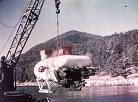|
The Pisces- a family of submersibles
 Designed by Al Trice, Pisces II is representative of early manned submersibles built in the late 1960s. With a weight of 6.5 tons and a 1525 meter (5000 foot) operating depth, the Pisces series of submersibles were proven workhorses in offshore exploration. Designed by Al Trice, Pisces II is representative of early manned submersibles built in the late 1960s. With a weight of 6.5 tons and a 1525 meter (5000 foot) operating depth, the Pisces series of submersibles were proven workhorses in offshore exploration.
Pisces II, the first production model of its design was built in 1969 by Hyco-International Hydrodynamics, on Riverside Drive in North Vancouver. The company went on to build 10 Pisces subs before folding in the late 1970s.
Pisces II is the centerpiece of a display highlighting the deep-sea technology legacy of Hyco at Deep Marine, a maritime museum- a portion of the old Versatile Pacific Shipyards site at Esplanade and Lonsdale, on the North Vancouver waterfront.
One of the Pisces subs, Pisces IV, was built for Russia in the early 1970s. Just before it was ready to be exported, the American government put pressure on the Canadian government not to allow the export. The Americans did not want the Russians to benefit by the leading-edge sub technology at the time. Canada refused to issue an export permit and the Canadian government bought the sub for the Department of Fisheries and Oceans.
The Pisces V and Pisces IV are three-person, battery-powered, submersibles with a maximum operating depth of 2,000 m (6,560 ft). These vehicles allow scientists to observe the deep sea through multiple view ports, video records, instrument placement, sample collecting, and environmental monitoring. The submersibles are launched and recovered with a specialized A-frame on the aft deck of their primary support vessel the R/V Ka‘imikai-o-Kanaloa.
HURL-Hawaii Underwater Research Laboratory has the unique advantage of having access to two deep-diving submersibles at the same time. This allows one submersible to conduct science dives while the other remains in ‘ready’ status in case of an emergency. Alternatively, some research projects might benefit from the use of two submersibles at the same time.
HURL’s Pisces submersibles were built by International Hydrodynamics of Vancouver in British Columbia and were classed by the American Bureau of Shipping. Each submersible weighs 13 tons and has a payload of 600 pounds. The personnel sphere of each sub is 7 feet in diameter and is made of HY 100 steel, the sphere can maintain 1 atmosphere of pressure at depths of at least 6,560 feet. This operating depth is ideal for the waters around the Hawaiian Islands where Pisces IV and Pisces V conduct the vast majority of their operations. Common dives sites include the undersea volcano Lo‘ihi (southeast of the Big Island of Hawai‘i), submerged banks in the main Hawaiian Islands, and banks and seamounts in the Northwestern Hawaiian Islands. Both submarines have two side-mounted reversible thrusters which allow the pilot to maneuver through a dive site at speeds up to 2 knots.
Technical specifications, Pisces IV & V:
Weight in air (lb/kg): 28,660/13,000
Payload in air (kg): 280
Dimensions (L*W*H feet/meter): 20`0*10`6*11`0/6.10*3.20*3.35
Propulsion: 2*side mounted reversible thrusters tiltable through 90 degree, Two lead-acid battery systems-120 VDC at 330 Ah capacity and12 - 24 VDC at 220 Ah capacity
Speed (sub/knots): 2.0
Range (sub n/miles@knots): 7-10 hours operational time
Diving depth (feet/meter): 6,560/2,000
Complement: 1 pilot, 2 researchers
Construction: International Hydrodynamics of Vancouver, British Columbia.
Personnel sphere, trim sphere, and aft sphere- HY 100 steel, 3 forward-looking acrylic windows, 6" diameter, HYCO manipulator- Schilling Titan 7 degrees of freedom.
Back to History Index
 |
USSR - Soviet Union |
1990 |
Pisces |
 |
Canada |
9999 |
Research submarine Pisces IV, dive no.150 on 6 November 1973, 9 November 1973, victoria |
|